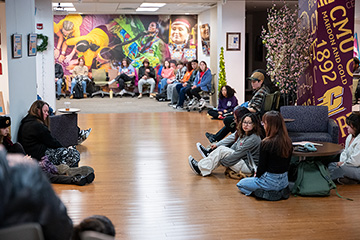Faculty research helps the world hear a little clearer
Grant aids development of better data for affordable hearing aids
Sarah Grinn will measure a lot of ears over the next five years in hopes of helping people hear better.
Grinn, a faculty member of Central Michigan University’s communication sciences and disorders department, is gathering data on the size and shape of the outer ear to improve the programming and safety of hearing aids.
Hearing aids are programmed using two measurements, Grinn said. One measurement is from the inner ear (the sensitive hearing organ that responds during a hearing test), and one measurement is from the outer ear (the part a doctor can look inside, which funnels and amplifies sound into the inner ear). Doctors of Audiology (Au. D.) use inner and outer ear measurements to precisely program hearing aid amplification for patients.
While the inner ear measurement could be completed with an online hearing test (some are accurate, some are not) or by the newest Apple iPhone hearing test feature (sometimes accurate, sometimes not), the outer ear measurement requires clinical training and equipment that only audiologists have. However, the $4,000-$7,000 price tag of your typical prescription hearing aid is high enough to cause some people to seek more budget-friendly alternatives.
Over-the-counter hearing aids ($300-$600) are a cheaper option, but they are pre-programmed with a one-size-fits-all approach to the outer ear measurement, which is based on the size and shape of the average adult male ear. For male and female ears of any other size and shape than the “average adult male,” this approach can lead to a mismatch in the amplification the patient needs to hear accurately by avoiding under-amplification and hear safely by avoiding over-amplification.
Grinn’s research intends to fix that discrepancy by establishing outer ear size and shape averages for male and female adults of all body sizes.
Right now, her research team is measuring the ears of 300 adults in six different height categories. They hope to wrap up this research within a year, after which her team will begin measurements on children’s ears.
That’s when the research will get more challenging.
Grinn said they will recruit 336 children between the ages of 3 months and 15 years, and will measure each child’s outer ears once a year for four years. While adults’ outer ears stay the same, children’s outer ears change in size and shape as they age, which changes how amplification funnels through them.
Over-the-counter hearing aids aren’t currently available for children, Grinn said. All hearing aids for children are prescribed by an audiologist.
Audiologists often have to use an average estimate of a child’s outer ear size based on the child’s age when programming hearing aids, because the child cannot sit quietly during the measurement process, Grinn said.
Children of the same age can have different body sizes, so using an estimate of outer ear size based on age often results in a mismatch between what the child needs and what a hearing aid provides.
“This research will improve audiologist-prescribed hearing aids for children and over-the-counter hearing aids for adults,” Grinn said.




